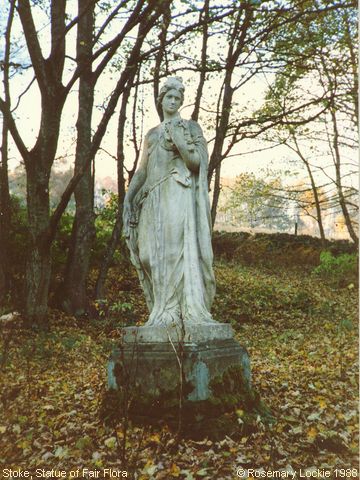Statue of Fair Flora, Stoke
This Statue always strikes me as a little incongruous stuck in the middle of a rather scrubby wood such as it is - and I grew up in a house some 500 yards away! She represents Flora, the Greek Goddess of Flowers, and stands in the Wood named in her honour - "Flora Wood" - just outside the modern village of Grindleford, beside a trackway branching off the B6521 road going towards Eyam. The story I was told by my mum as a child was that she was originally sited at Chatsworth House, but she was given to the owners of the Hall at Stoke as a gift. Indeed, Chatsworth House has a number of this type of Italian-style statue in its grounds. However, the lady of the house at Stoke Hall became convinced the statue had brought bad luck, and she also became frightened by it at night, so it was transferred at her insistence to its present site. Many strange tales have become associated with the statue over the years. On the one hand, the statue is supposed to represent a young lady who was murdered by a jealous lover; on the other, the statue is said to be a memorial to a girl who drowned in the River Derwent when eloping with her lover across stepping stones above the Leadmill Bridge at Hathersage. A further tale involves a real 'Fair Flora' living in a tiny cottage near Eyam, the so called "Astrologer's Daughter" immortalised in a long ballad by J. Castle Hall. Victor, the son of a local squire, was betrothed to Flora but then was called away to war, to fight for his country. Many months elapsed, and when he failed to return, Flora, in her sorrow, is said to have pined away and died. Or... as told by John Merrill in his book 'Derbyshire Folklore' (JNM Publications, Winster, 1988, ISBN 0 907496 331 8) - a combination of all of them! He tells of Flora as a servant at Stoke Hall living about 120 years ago. She was murdered whilst her betrothed - a soldier - was fighting abroad, and Stoke Hall's owners being deeply shocked had a statue erected in her memory. However, one night the lady of the house had a fancy that she saw the statue move. Such fancies are easily understood if one imagines a time when the best lighting was likely to be the flickering light of an oil lamp, reflecting off the stark whiteness of the statue against a dark background of surrounding trees! Understandably she was frightened by the experience, so at her insistence the statue was moved to the present site for safety. No doubt each of these stories, as with all good Family History Legends, do have an element of truth to them - similar events really did happen to local people. In keeping with the myth of the modern age, the most recent theory is that Fair Flora was a fertility symbol, and there are rumours the young girls of the village deck the statue with garlands of flowers, and go dancing around it at dawn on May Day... In all seriousness, I think I can recall my mother telling me they used to hang garlands of flowers around her neck when they were kids, but I suspect this was more a "dressing-up" game than a hark back to the times of "The Green Man"! In the 1950's the Statue was vandalised - some ramblers knocked the head off; however it was kept safely by a nearby resident, and in the 1980's the Parish Council arranged for it to be restored to its former glory (as you will see from the accompanying photograph). (Information provided by Rosemary Lockie)
Image contributed by Rosemary Lockie in October 1988.
|
||
